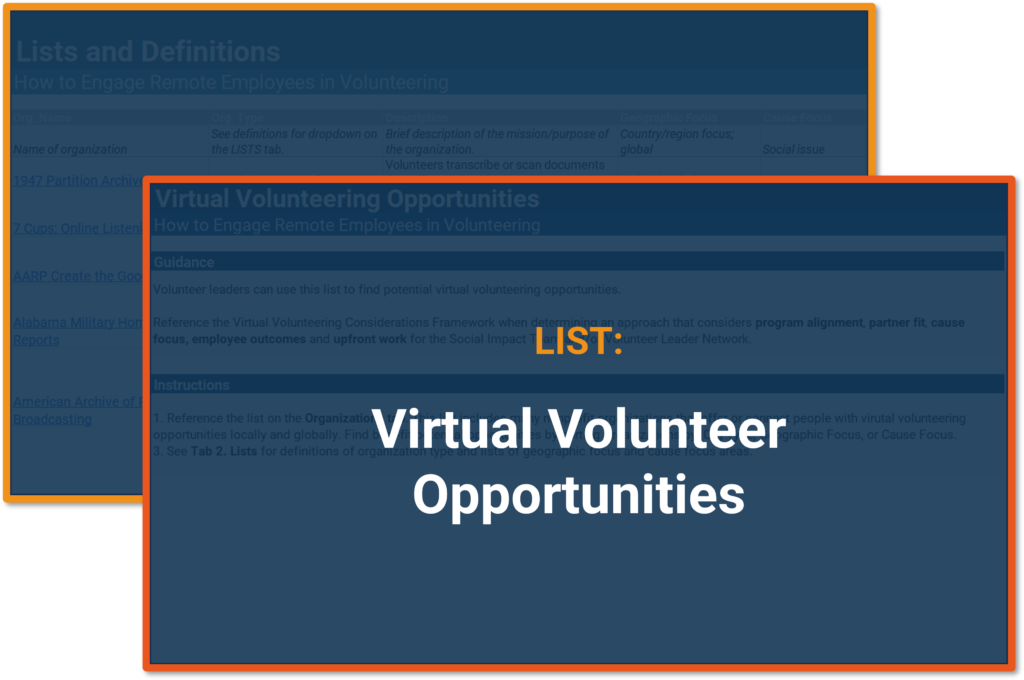The past four years of remote work have seen wild ups and downs. In 2020 companies quickly pivoted to work-from-home models in response to the COVID-19 pandemic. Over time, we were able to see a demonstrated increase in recruitment and retention of remote employees over in-office employees. However, companies have initiated return-to-office policies and face subsequent backlash from employees. But overall, remote work is trending up, and according to ZipRecruiter’s 2023 Employer Survey, it is here to stay. Even among companies that have limited remote work more recently, only 14% have required workers to return to the office in-person five days a week. That means the vast majority of office jobs that can be done remotely are fully remote or hybrid.
This change in where and how employees work demands that corporate volunteering programs adapt and evolve. As we look to the future of employee volunteering, it’s clear that remote-inclusive strategies will play an increasingly critical role in driving Social Impact programs and engaging employees across distributed teams.
Virtual Volunteering Opportunities List
Volunteer leaders looking for more virtual volunteering opportunities for employees? Send them Realized Worth’s list of 160+ nonprofit organizations and websites. We’ve made this list sortable by cause focus area and inclusive of one-off opportunities as well as longer-term projects.
Remote inclusion in employee volunteering programs
Many corporate Social Impact leaders face challenges activating or sustaining remote employee involvement. Virtual and remote-friendly opportunities are often:
- Created as an add-on to existing in-person volunteering
- Not well-supported with time, attention, or investment
- Not well-integrated in volunteer programming or strategy
Common engagement challenges can be addressed with remote-centric tactics. Let’s look at three frequently reported challenges:
- Virtual and remote volunteer opportunities don’t speak directly to remote employee values, motivations, and barriers.
- Remote-centric tactic: Identify top values held by remote employees in your organization and align opportunities and communications to those values. For example, choose virtual volunteering options that allow remote contribution on flexible schedules, with intentional moments of connection.
- Virtual and remote volunteer opportunities are perceived as “less meaningful” because of physical distance vs. in-person opportunities.
- Remote-centric tactic: Facilitate volunteer events using the Transformative Approach to immerse volunteers in meaning.
- Remote employees need to be able to access volunteer opportunities, no matter where they live or when they work.
- Remote-centric tactic: Include fully virtual, asynchronous, and/or from-home opportunities to volunteer to improve accessibility.
Social REV members: Find the entire How-To Guide: Engage Remote Employees in Volunteering
Appeal directly to remote employees with values-based recruitment
Address challenge #1 above by discovering exactly what remote employees in your organization value most. An empathy map exercise helps uncover your target audience’s wants, needs, goals, and feelings so that you can align program strategy and the value proposition of employee volunteering effectively. During this exercise, you’ll put yourself in the shoes of your remote employees – first talk with them, go where they meet online, hold listening sessions. Build your understanding of their perspectives, needs, and challenges. What do they value most in their work and personal lives? What motivates them to engage in volunteering activities? What barriers might prevent them from participating?
Social REV members: Find the Empathy Map for Remote Employees Framework and Remote Employee Engagement Feedback Prompts for a jumpstart.
After building a clear understanding of what drives remote employees, tailor messaging accordingly. For example, if your remote employees value flexibility and work-life balance, highlight how virtual volunteering opportunities can fit seamlessly into their schedules. If they’re motivated by skill-building and professional development, emphasize how volunteering can help them acquire new skills and expand their networks. If they’re looking for more connection at work, highlight opportunities to interact on a deeper level with fellow volunteers (more on that last one in the next section).
Get these messages across by using the right channels and formats to reach your remote employees. With so many competing priorities and distractions in the virtual workspace, crafted messages need to cut through the noise and grab their attention. Consider using video testimonials, employee spotlights, and other engaging visual content to bring your volunteering opportunities to life. Leverage internal communication platforms like Slack, Teams, or your company intranet to meet your remote employees where they are.
Finally, don’t forget the power of personalization in your recruitment efforts. Whenever possible, tailor your communications to the specific interests and preferences of individual remote employees or teams. Use data from past volunteering experiences or employee surveys to segment your audience and deliver targeted messages that resonate with their unique values and motivations.
Continue to refine your approach based on what resonates most with your remote workforce. With the right messaging and strategies, you can build a culture of volunteerism that transcends physical distance and brings your remote employees closer to purpose at work.
Social REV members: Find the Values-Aligned Recruitment Communications for Remote Employees for guidance.
Meaningful experiences with the Transformative Approach
“Virtual volunteering is nice, but what do you really experience without physically getting your hands dirty alongside other people?” We hear this sticky question often, and while of course physical volunteering offers an experience that can’t be replicated online, we can still create meaningful, Transformative virtual volunteering experiences. It requires both appropriate adaptation of the most essential elements of Transformative Volunteering (adapting the non-negotiables to an online setting), and some thinking outside the box on tools and tactics (taking a remote-first perspective for the “how”).
If you’re familiar with the Transformative Approach to Social Impact, you know the three Keystone Behaviors of volunteer leaders:
- The Brief: held before the volunteering event begins. This is a time for a leader – either a volunteer leader from your organization or from your nonprofit partner organization– to frame the event. The Brief helps volunteers consider the real meaning behind the work they are about to complete and shift the focus from task efficiency to who the task is for and how it benefits them.
- Guiding Volunteer Experiences: During the event, leaders create an environment where volunteers have their needs met, can contribute at their highest level, and have a great experience that supports their development as a volunteer.
- The Debrief: the final and perhaps most critical component of Transformative Volunteering, as it helps participants reflect on their experience, process their emotions, and identify key learnings and insights. The Debrief is essential because it invites participants to critically reflect on their experience. Without the Debrief, participants are often left to make sense of their experience on their own, and lacking key insights, this can lead to discouraging or inaccurate conclusions.
These pillars of Transformative Volunteering frame a volunteer experience in order to create space for transformation within individuals. They are non-negotiable.
Practicing the Three Keystone Behaviors in a Virtual Setting
When volunteering virtually, employees have unique opportunities to experience the Transformative Approach.
- The Brief: In a virtual setting, some of the priming that happens in the Brief also expands organically into communications on multiple platforms. Volunteers and volunteer leaders may begin talking about the true purpose of a volunteer engagement ahead of the event on relevant Slack channels, for example. Intentional touchpoints beyond the live video call can help introduce the volunteering opportunity, set expectations, and help volunteers connect with the larger purpose behind their efforts.
- Guiding Volunteer Experiences: involves providing support, direction, and encouragement throughout the virtual volunteering experience in a way that meets each volunteer at their highest level of contribution (not sure how to determine this? Brush up on the stages in The Journey of the Volunteer.).
- For some virtual volunteering projects, this looks like providing structure and guidance that allows remote volunteers to fully engage in the experience without feeling overwhelmed or disconnected. This might include assigning virtual team leaders, creating breakout rooms for small group discussions, or using collaborative tools and workspaces like Google Docs or Trello to keep everyone on track.
- For some virtual volunteering projects, there is little to no opportunity to guide volunteers during a group virtual event. When volunteers complete a task individually, you can balance the lower-touch, more transactional task time with expanded Brief and Debrief conversations.
- The Debrief: An online Debrief provides a unique opportunity in the chat function. Each volunteer can articulate their reflection simultaneously, allowing more volunteer voices to be heard. Reflections can also be memorialized with key takeaways synthesized from the chat log. As with the Brief, oftentimes Debrief reflections continue in subsequent conversations and spaces online. This is an excellent opportunity to continue dialogue that facilitates mindset shift.
Social REV members: Find the Transformative Volunteering Online Training Aid to equip volunteer leaders to effectively facilitate and execute for remote employees.
Virtual volunteering
Remote employees will continue to make up a significant portion of the workforce, and we are starting to uncover effective ways to facilitate meaningful volunteer experiences specifically for them. Ready to find and scope virtual volunteer experiences?
With the rise in remote work comes an increase in virtual volunteer opportunities. Many volunteer opportunity hubs like VolunteerMatch provide filters for virtual vs. in-person opportunities. Organizations like Zooniverse gather many opportunities to contribute to projects around the world from any location.
We’ve seen teams add monthly volunteering sessions to their schedule via Missing Maps, turning it into a friendly competition employees look forward to. Company leaders have taken skills-based, pro bono, and board service beyond their local communities via virtual projects. We’ve seen grassroots, online-only organizations make excellent nonprofit partners. Whether you’re tweaking existing programs or initiating a complete overhaul or launch, explore the current landscape of virtual volunteering opportunities.
We’ve put together a list of 160+ nonprofit organizations and websites offering virtual volunteering opportunities, and we’ve made it sortable by cause focus area. You’ll find quick, one-off opportunities as well as longer-term projects.
Social REV members: Find the Virtual Volunteering Opportunities List to get started. Not-yet members can access this list here.
Ultimately, the future of employee volunteering demands corporate Social Impact practitioners be nimble and responsive to how and where colleagues work and what they value most. It demands inclusive, accessible volunteer experiences that facilitate individual mindset shifts toward empathy and connection. The future of employee volunteering is a culture of volunteerism that runs deeper than any policy or workspace. And, if you’ll excuse the cliché, the future is now.







